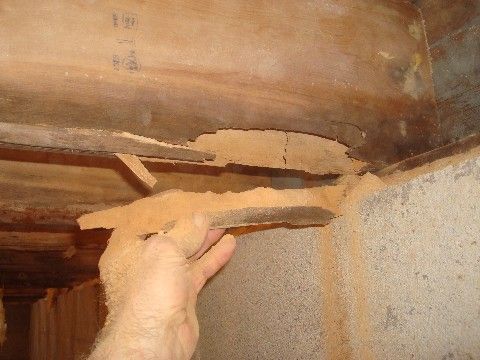
The Bad and The Ugly
After removing the old insulation its clear to see the full extent of damage caused by excess moisture in this crawlspace. The photos show The Bad and The Ugly. The “epicenter” of damage is the joist next to the wire that started this epic in the first place. Check out the creepy mold growths and hard-to-believe powdered wood. Incredible. The joists had a kind of thin crust which, when cracked, allowed clouds of powder to pour out.
The Good
With the floor framing fully exposed and partially removed it appears that a dozen joists will need to be replaced, along with the associated rim joist and sill plates. The challenge here is lifting the walls enough to cleanly remove the rotten structural members and get the replacements into place. While it would only take a few hours to frame and sheath a 16 x 24 deck in new construction, something tells me this will be considerably more time consuming. The Good is that the worst of the nasty tear-out phase is over!
Rebuilding Strategy
There are no doubt many feasible ways of lifting the walls that this floor system supports. With the given site conditions and framing configuration I first decided to try to lift the walls by the ceiling framing to provide maximum accessibility for the removal/ replacement process. Good thing there are many feasible ways to do this lift because my first attempt quickly failed when the ceiling joists began separating from the top plates. So on to plan B. A brainstorm brought in the idea of some bomber lifting fixtures to lift from under the bottom plates to relieve the weight of the structure above. A test run of the lifting fixtures using a 12 ton and a 20 ton bottle jack placed on the footing and a doug fir 4×4 went well: plenty of power to get the job done. Nothing like a little welded steel to show this old house who’s boss. I should practice reading facial expresssions more since I’m not sure if my client was amused by my quip that with this lifting method, I could make this room a 2-story if he wanted.
The Light in the Tunnel
With the damage exposed and assessed and plans coming together for rebuilding this floor system, there is a faint light showing in the end of the tunnel. Check back for the next post to see if that light is in fact the end of the tunnel or just a freight train coming the other way…
Matt
——————————————————————-
See earlier posts in this saga:
Aftershock: A Moldy Crawlspace Nightmare, Part 2
Also see Green Building Advisor’s article: Crawlspaces: The Downsides of Basements with Few of the Benefits
Fine Homebuilding Recommended Products
Fine Homebuilding receives a commission for items purchased through links on this site, including Amazon Associates and other affiliate advertising programs.

8067 All-Weather Flashing Tape

Reliable Crimp Connectors

Handy Heat Gun




























View Comments
So have you identified the source of the moisture, Matt?
This seems like an awful lot of fungal growth (devastation) for a desert climate like South Dakota.
When I was buying my house the inspector found something similar but worse. The rim joist and sill plate had to be replaced and about 2' of the joists had to be sawed off and sistered with 2x12s. Some additional beams were installed with new cement footings to help carry the load. The problem was no vapor barrier, so all is fine now.
Regards Tony
Did you check the attic. With this must moisture in the crawlspace, vapor diffusion has possibly resulted in condensation on the underside of the roof deck. Informtion on mold and water damage can also be found at my blog site, cleanlinest.wordpress.net
Correction in blog site cleanlinest.wordpress.com
With dry wood mold clouds dropping out, I would hate to be your doctor. Although no established healthy level limits of toxic mold have been established by the government, no one should attempt a job like this without the proper containment and protection equipment. Any mold environment that I come across is not remediated by me but by a specially trained mold removal subcontractor. You entered an extremely unhealthy environment and although you did a fine job fixing the problem you may have even made the problem worse by not containing or eliminating the mold.
With all that wood powder pouring out of joist you didn't think pressure treated wood was needed for the rebuild? It seems like the powder was a clue that mold wasn't the only thing that damaged those joist.